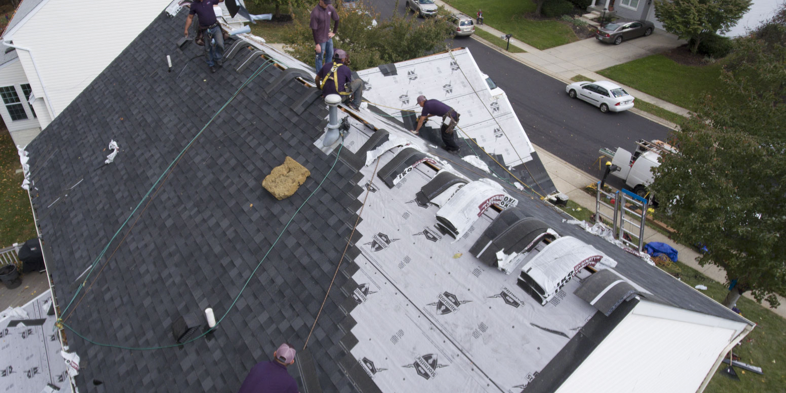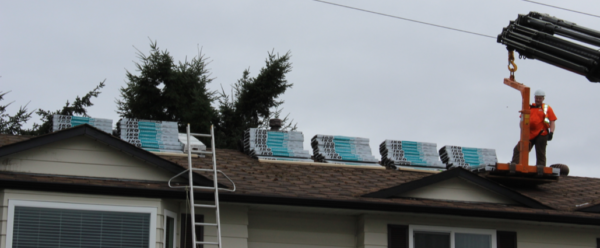How to Properly Stack Shingles on a Roof

By IKO.
Disclaimer: Please use caution when stacking bundles on sloped roofs.
To save time, most roofers prefer to stack several shingle bundles on the roof before beginning to install them. However, shingles can be damaged if they are stored or stacked incorrectly, which may reduce the life span of the roof. Stacking bundles properly is also key to preventing damage to other components of the roof.
The essentials of properly stacking asphalt shingles on a roof are as follows. This article expands on these tips below:
- On high-pitched roofs, nail down a board just below where you will lay the shingle bundles. This will prevent the shingle bundles from sliding, which would be a safety hazard and could damage the roof.
- Carefully lay the bundles flat out on the roof. Do not take them out of their packaging before setting them down.
- You may carefully lay 3-tab shingle bundles over the roof ridges or hips, so long as you don’t lay too many bundles in the same spot. Laminate shingles should, preferably, not be bent over the roof ridge or hips.
- Only stack a few bundles high, so there’s no risk of them toppling over. A shingle bundle typically weighs 75 – 80 pounds, so stacking many of them could put a lot of pressure on the roof, which may cause damage.
- Choose a new location for other bundles, so that the roof doesn’t have to hold too much weight in one area. This also makes the shingles easier to access when you’re working on different parts of the roof.
- Avoid stacking the shingle bundles near vulnerable areas of the roof where damage is more likely, including the valleys.
Only Stack Shingles on Flat Surfaces Whenever Possible
Some contractors will intentionally stack the shingle bundles over the roof’s ridge. They may call this process “breaking the bundles,” which may help separate 3-tab shingles from one another. However, you must do this carefully. If you drop the bundles with force, you may damage them or the roof, especially in cold weather.
Also, breaking the bundles isn’t recommended for laminate shingles because their two-layer construction resists bending. Flexing them could damage them or misalign the layers. It is ideal to lay them flat instead.
In the image above, you can see that the roofing team is unloading the shingle bundles with the help of a conveyor. The shingle bundles have been stacked correctly. If you were to stack the bundles higher than shown here, therefore concentrating the load of many bundles in a small area, you may cause long-term issues with the roof structure.
The Dangers of Stacking Shingles in Heat and Cold
Asphalt shingles become more malleable in the heat, so you will need to be extra careful when moving a warm bundle. Plus, it may become more difficult to remove 3-tab shingles from the bundle in hot weather because the sealant on each shingle is aligned in the center of the bundle and may hold together. This tends not to happen with laminate shingles because they are packaged so that the sealant is on the edge of the bundles, not the center.
The solution to this hot-weather bond is to simply lay the 3-tab shingle bundles so that the granule side faces up. This may make it easier to remove the individual shingles from the package.
Also consider that the sealant on asphalt shingles is heat-activated. To avoid activating the sealant early, store the shingle bundles in the shade for as long as possible. When you do bring them up to the roof, take advantage of any shaded areas.
In very cold weather, asphalt shingles are less flexible and more likely to break, especially hip and ridge cap shingles. Some contractors will put hip and ridge cap shingle bundles into their truck cab to warm them up before they are installed. Either way, you must take extra care not to drop the shingle bundles with force when roofing in cold weather.
Avoid Debris When Stacking Shingles
While you should be roofing on a clean surface, debris may blow onto the roof while you are installing your shingles. If debris collects on the shingle’s adhesive band, it may not seal properly, limiting the roof’s wind resistance. Keep shingles in their packaging up until you install them in order to minimize their exposure to dust, dirt and other debris.
Whether you’re using asphalt shingles or another product, stacking your materials on a roof requires you to consider safety and how to minimize the risk of damaging the roof and your materials. Following the tips above will help keep your roof installations top-notch. To learn more about roofing best practices, visit our learning and idea center.
Learn more about IKO roofing products at www.iko.com.
Editor’s note: This article first published in IKO’s blog and can be viewed here.























Comments
Leave a Reply
Have an account? Login to leave a comment!
Sign In